Courtesy of VPAP, see below for some State Senate and House of Delegates districts where incumbents are “paired” or “tripled” up; what the 2016 Trump vs. Clinton vote looked like; and how many of each incumbent’s voters have shifted into the new district they’ve been placed in by the Virginia Supreme Court’s redistricting “Special Masters.” By looking at these numbers, we can get a better feel for who might end up winning or losing this frenetic game of “musical chairs.”
SD2 (Trump won 63.7% of the vote in 2016): Senators Creigh Deeds (D), Emmett Hanger (R) and Mark Obenshain (R) “tripled.” Based on the Clinton/Trump vote and the following “voting age population” “shifting voters” numbers, it looks like Sen. Obenshain has a big advantage, while the district is unwinnable for Sen. Deeds (who might move to the new SD11, based in Charlottesville, Albemarle County, Nelson County, Louisa County and Amherst County?).
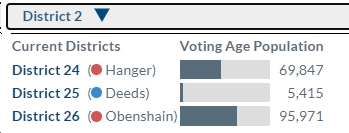
SD4 (Trump won 50.2% of the vote here in 2016): Senators John Edwards (D) and David Suetterlein (R) “paired.” Based on the Clinton/Trump vote and the following “voting age population” “shifting voters” numbers, it looks like Sen. Suetterlein would have the edge based on partisan lean, although Sen. Edwards would have more of his constituents in the new district. Would Sen. Edwards try to hold on to this seat or would he retire?

SD12 (Trump won 53.1% of the vote here in 2016): Senators Ghazala Hashmi (D) and Amanda Chase (R) “paired.” Based on the Clinton/Trump vote and the following “voting age population” “shifting voters” numbers, it looks like Sen. Chase would have the advantage. Which is a depressing thought for numerous reasons…
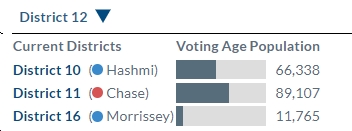
SD18 (Clinton won 59.7% of the vote here in 2016): Senators Louise Lucas (D) and Lionell Spruill (D) “paired.” Based on the Clinton/Trump vote and the following “voting age population” “shifting voters” numbers, it looks like it could be a knock-down/drag-out fight between Senators Spruill and Lucas. Would one of them move to a neighboring district (e.g., SD21)?
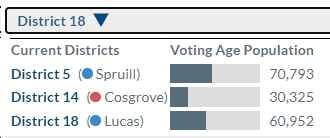
SD20 (Trump won 51.7% of the vote here in 2016): Senators Bill DeSteph (R), Jen Kiggans (R)and Lynwood Lewis (D) “tripled.” Based on the Clinton/Trump vote and the following “voting age population” “shifting voters” numbers, it’s definitely a Republican-leaning district, but whether DeSteph or Kiggans would win a primary is hard to say. Of course, Kiggans is running for U.S. House of Representatives, so we’ll see how that turns out. And what would Sen. Lewis do (e.g. move to a new district)?
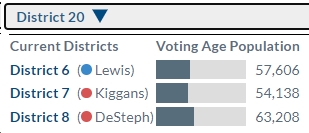
HD6 (Clinton won 58.6% of the vote here in 2016): Delegates Kathleen Murphy (D) and Rip Sullivan (D) “paired.” Based on the Clinton/Trump vote and the following “voting age population” “shifting voters” numbers, it looks like Del. Murphy would have the edge, assuming she decides to run again for the seat and not retire (as has been rumored she might do)…
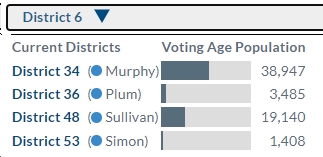
HD10 (Clinton won 58.7% of the vote here in 2016): Delegates David Bulova (D) and Dan Helmer (D) “paired.” Based on the Clinton/Trump vote and the following “voting age population” “shifting voters” numbers, it looks like Del. Helmer would have the advantage over Del. Bulova…
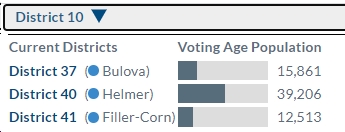
HD12 (Clinton won 66.8% of the vote here in 2016): Delegates Marcus Simon (D) and Mark Keam (D) “paired.” Based on the Clinton/Trump vote and the following “voting age population” “shifting voters” numbers, it looks like Del. Keam would have the advantage over Del. Simon (who doesn’t seem to have many great options, assuming this map holds).
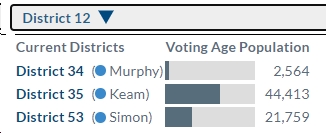
HD15 (Clinton won 61.8% of the vote here in 2016): Delegates Eileen Filler-Corn (D) and Vivian Watts (D) “paired.” Based on the Clinton/Trump vote and the following “voting age population” “shifting voters” numbers, Del. Filler-Corn has the overwhelming advantage.
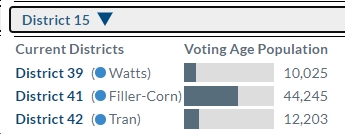
HD16 (Clinton won 67.3% of the vote here in 2016): Delegates Paul Krizek (D) and Mark Sickles (D) “paired.” Based on the Clinton/Trump vote and the following “voting age population” “shifting voters” numbers, Del. Krizek looks to have a big advantage over Del. Sickles.
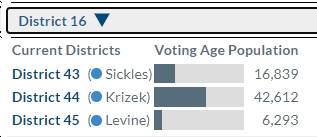
HD25 (Clinton won 61.3% of the vote here in 2016): Delegate-elect Briana Sewell (D) and Delegate Luke Torian (D) “paired.” Based on the Clinton/Trump vote and the following “voting age population” “shifting voters” numbers, it looks like Delegate-elect Sewell (who succeeds Del. Hala Ayala) might very well have the advantage over Del. Torian, but Torian is a long-time incumbent, while Sewell just won the seat, so…we’ll see?
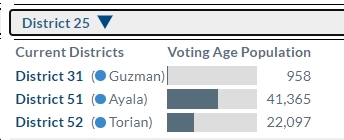
HD30 (Trump won 50.1% of the vote here in 2016): Delegates Dave LaRock (R) and Michael Webert (R) “paired.” Based on the Clinton/Trump vote and the following “voting age population” “shifting voters” numbers, it looks like Del. LaRock, sad to say, would have a big advantage over Del. Webert in this new district.
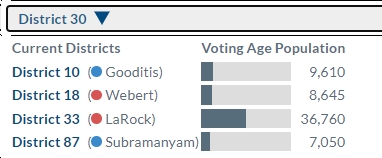
HD36 (Trump won 58.5% of the vote here in 2016): Based on the Clinton/Trump vote and the following “voting age population” “shifting voters” numbers, it looks like Del. John Avoli (R) would have a major advantage over Del. Ronnie Campbell (R).

HD44 (Trump won 74.1% of the vote here in 2016): Based on the Clinton/Trump vote and the following “voting age population” “shifting voters” numbers, it looks like it would be a close matchup between Delegates Israel O’Quinn (R) and Will Wampler (R).
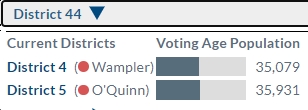
HD47 (Trump won 72.9% of the vote here in 2016): Based on the Clinton/Trump vote and the following “voting age population” “shifting voters” numbers, it looks like Del.-elect Wren Williams (R) might have a small advantage over Del.-elect Marie March (R), but who knows…
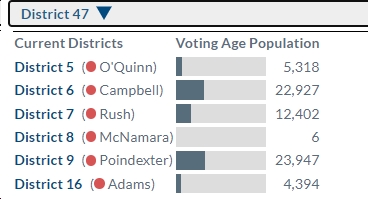
HD49 (Trump won 51.7% of the vote here in 2016): Based on the Clinton/Trump vote and the following “voting age population” “shifting voters” numbers, it looks like Del. Danny Marshall (R) would have a big advantage over Del. James Edmunds (R).
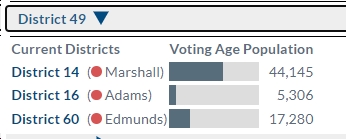
HD52 (Trump won 52.5% of the vote here in 2016): Based on the Clinton/Trump vote and the following “voting age population” “shifting voters” numbers, it looks like Del. Wendell Walker (R) would start out with an advantage over Del. Kathy Byron (R).
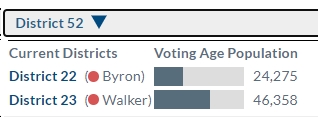
HD60 (Trump won 65.3% of the vote here in 2016): Based on the Clinton/Trump vote and the following “voting age population” “shifting voters” numbers, it looks like Del. Scott Wyatt (R) would have the advantage over Del. Buddy Fowler (R).
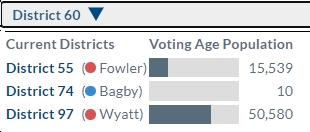
HD67 (Trump won 56.2% of the vote here in 2016): Based on the Clinton/Trump vote and the following “voting age population” “shifting voters” numbers, it looks like Del. Margaret Ransone (R) would have a huge advantage over Del. Bobby Orrock (R).
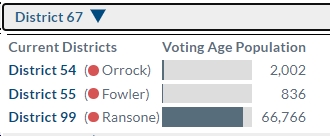
HD78 (Clinton won 69.3% of the vote here in 2016): Delegates Dawn Adams (D), Jeff Bourne (D) and Betsy Carr (D) “tripled.” Based on the Clinton/Trump vote and the following “voting age population” “shifting voters” numbers, it would probably come down to Del. Bourne vs. Del. Adams.
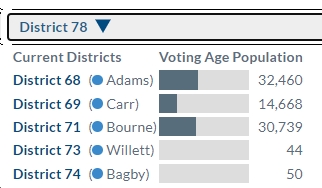 HD80 (Clinton won 73.1% of the vote here in 2016): Delegates Lamont Bagby (D) and Schuyler VanValkenburg (D) “paired.” Based on the Clinton/Trump vote and the following “voting age population” “shifting voters” numbers, the advantage definitely goes to Del. Bagby…
HD80 (Clinton won 73.1% of the vote here in 2016): Delegates Lamont Bagby (D) and Schuyler VanValkenburg (D) “paired.” Based on the Clinton/Trump vote and the following “voting age population” “shifting voters” numbers, the advantage definitely goes to Del. Bagby…
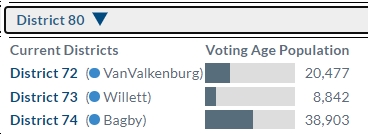 HD88 (Clinton won 64.3% of the vote here in 2016): Delegate Don Scott (D) and Delegate-elect Nadarius Clark “paired.” Based on the Clinton/Trump vote and the following “voting age population” “shifting voters” numbers, Del. Scott looks to have a huge advantage here…
HD88 (Clinton won 64.3% of the vote here in 2016): Delegate Don Scott (D) and Delegate-elect Nadarius Clark “paired.” Based on the Clinton/Trump vote and the following “voting age population” “shifting voters” numbers, Del. Scott looks to have a huge advantage here…
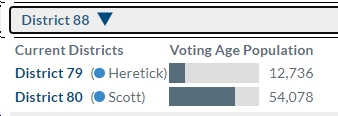
HD90 (Trump won 60.8% of the vote here in 2016): Delegates Jay Leftwich (R) and Cliff Hayes (D) “paired.” Based on the Clinton/Trump vote and the following “voting age population” “shifting voters” numbers, Del. Leftwich has the overwhelming advantage. Would Del. Hayes move to a new district? Presumably so…
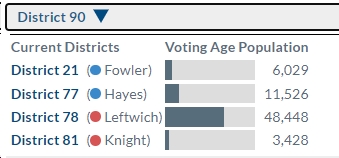 HD98 (Trump won 58.1% of the vote here in 2016): Delegates Barry Knight (R), Glenn Davis (R) and Kelly Fowler (D) “tripled.” Based on the Clinton/Trump vote and the following “voting age population” “shifting voters” numbers, it looks like Del. Davis would have the advantage, but only narrowly, over Del. Knight. Would Del. Fowler move to a new district? It’s certainly a possibility…
HD98 (Trump won 58.1% of the vote here in 2016): Delegates Barry Knight (R), Glenn Davis (R) and Kelly Fowler (D) “tripled.” Based on the Clinton/Trump vote and the following “voting age population” “shifting voters” numbers, it looks like Del. Davis would have the advantage, but only narrowly, over Del. Knight. Would Del. Fowler move to a new district? It’s certainly a possibility…
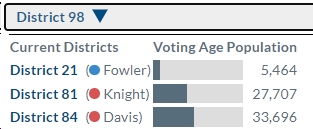



![Saturday News: “Trump Has a Recipe for War and Corruption, Not Peace”; “Trump and Mamdani’s White House Lovefest Leaves Trump Allies ‘Shocked'”; MTG Announces Resignation, “expects the MAGAs to lose the midterms, and for Donald Trump…to be impeached”; Thanks to Trump, “[VA’s] fiscal situation is not healthy”](https://bluevirginia.us/wp-content/uploads/2025/11/montage1122-238x178.jpg)











